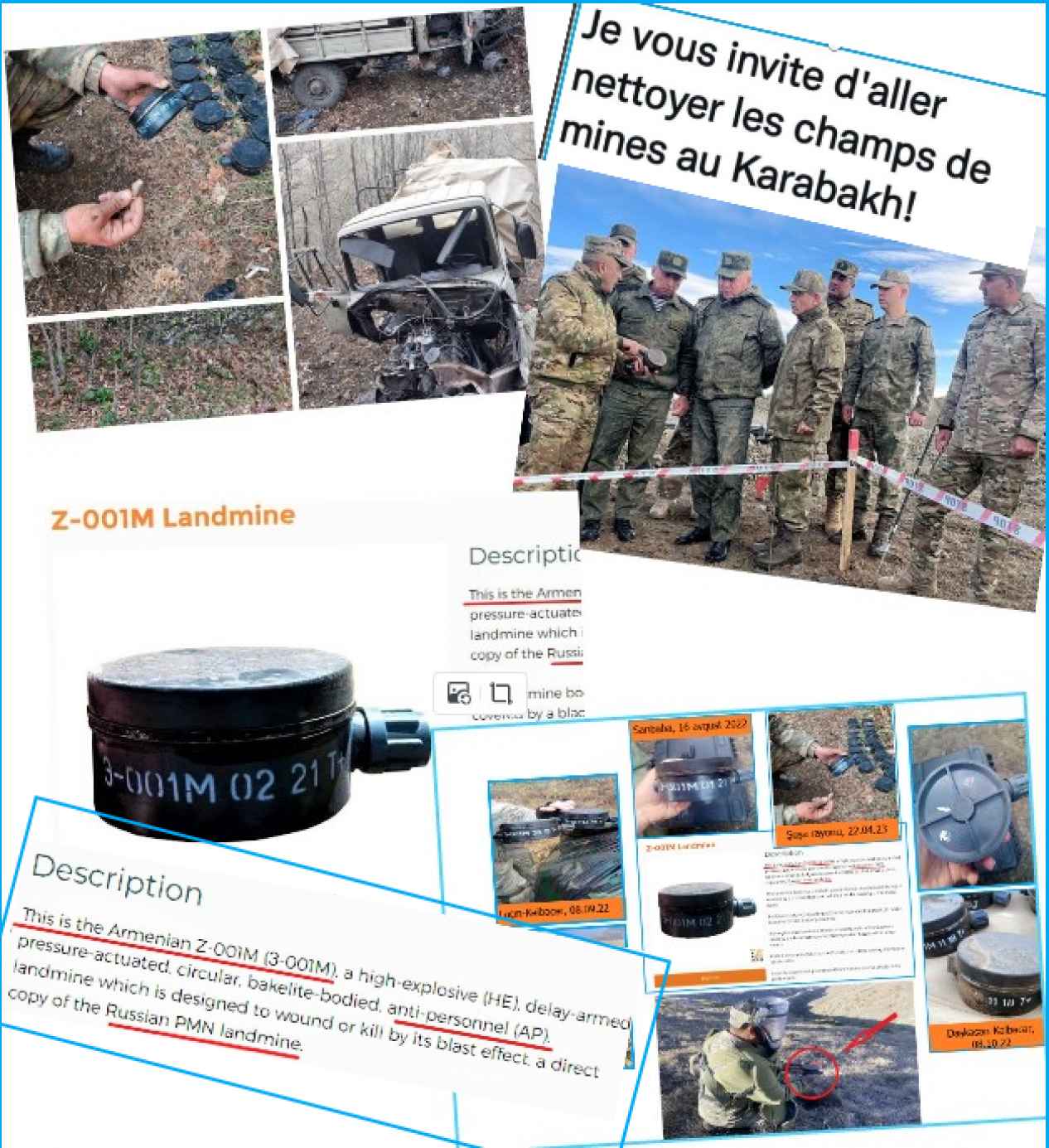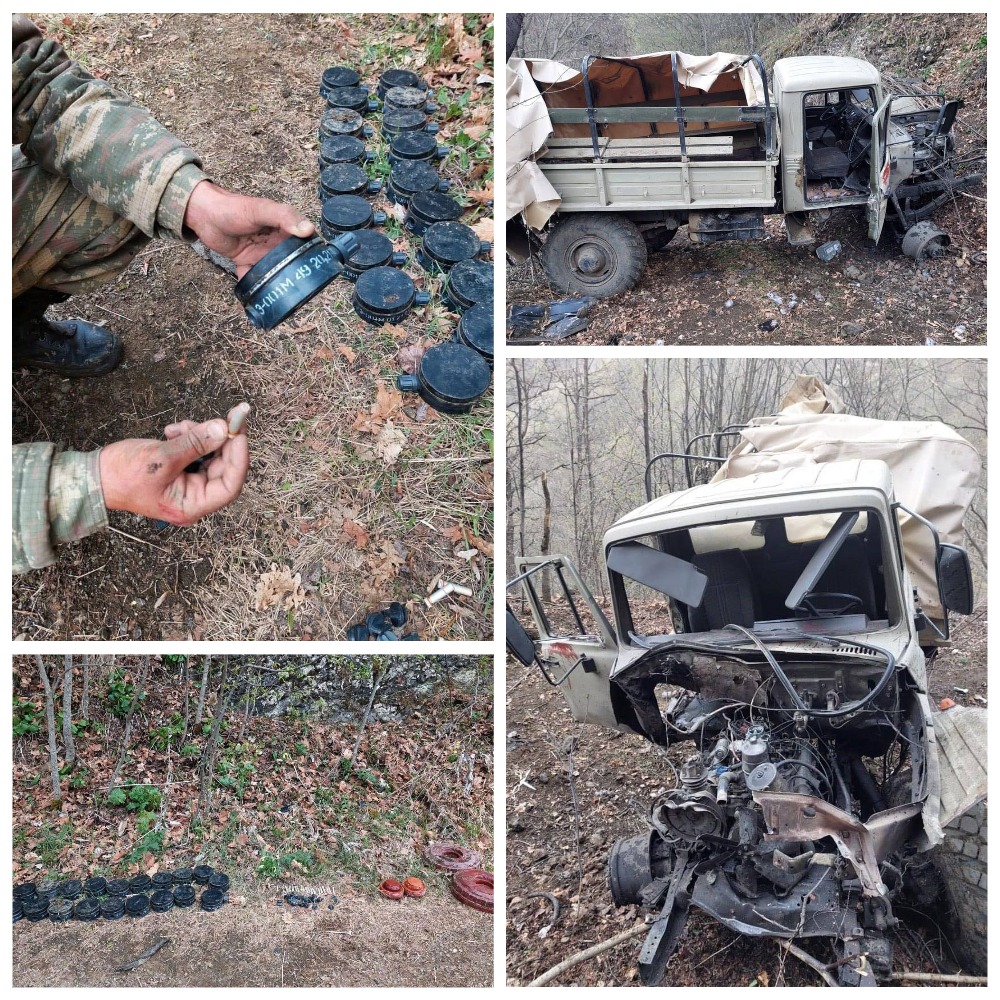
On April 22, 2023, a military truck of the Azerbaijan Army carrying security equipment to Azerbaijani positions located on the heights around the village of Allahgulular in Shusha district fell into a mine buried by Armenians and exploded. As a result of the incident, 3 servicemen of the Azerbaijan Army were injured. 2 anti-tank mines and 19 anti-personnel mines produced in Armenia in 2021 were found in that area during the search conducted by the engineering and fortification units of the Ministry of Defense.

This incident is not the first such fact. Armenia's "mine terror" is causing greater consequences after the 44-day war (2020). If we look at the chronology of the last 7-8 months alone, what we said will be confirmed.
According to information released on August 31, 2022, 1,318 "PMN-Э" type mines were discovered in the territory of Lachin region only in the period of August 15-31, 2022. (link)
According to information released on October 5, 2022, 230 mines buried by Armenian saboteurs in Kalbajar and Dashkasan were neutralized. (source) It was reported that the next 118 "PMN-Э" anti-personnel and 4 "TM-62M" type anti-tank mines, as well as 108 "PMN-Э" type mines, were buried in the territory of Dashkasan region by the Armenian sabotage groups.
Engineer-fortification units of the Azerbaijan Army discovered 5 anti-personnel mines of the "PMN-Э" type, manufactured in Armenia, buried by Armenian military units in the direction of Khojaly region. source
Engineer-fortification units of the Azerbaijan Army discovered 379 more mines buried by Armenians in Kalbajar district. It was reported that as a result of the demining activity, 370 anti-personnel "PMN-Э" and 9 anti-tank "TM-62" type mines were discovered in the Alagoller area of the region and in other directions on September 24 and 25 and were neutralized in accordance with safety regulations. source

During August-November, 2,728 mines were discovered in Kalbajar and Lachin. It was noted that since August of this year, 1,119 Armenian-made mines (2,728 in total) have been detected and neutralized in the Kalbajar and Lachin areas of the border between Azerbaijan and Armenia, and 1,609 in the territory of the Karabakh economic region. source
On November 21, 2021 Armenian-made 350 PMN-Э type anti-personnel mines buried by Armenian armed groups, which have not yet been removed from Azerbaijan, were discovered in the northern direction of Saribaba Height.
There are too many such facts. Faktyoxla Lab. will try to clarify the fact that the anti-personnel mines mentioned are manufactured in Armenia.
For this, it is necessary to pay attention to the "Collective Awareness to UXO" website, which has been operating for more than 10 years, specializing in unexploded ordnance. If we write "Armenia" in the search section of that site, we can get information on the list and prices of mines produced and widely used in this country. In the second attempt, if we write "Armenia" in the "country of mine production" column and "Azerbaijan" in the "country of application" column on the same site, the Z-001M (З-001M) type anti-personnel mine is found.

The information section about this mine reads: "This is the Armenian Z-001M (З-001M), a high-explosive (HE), delay-armed, pressure-actuated, circular, bakelite-bodied, anti-personnel (AP), landmine which is designed to wound or kill by its blast effect, a direct copy of the Russian PMN landmine."

Armenia's disregard for the conventions on the prohibition of anti-personnel mines is also confirmed by international organizations and specialized institutions in this field.

In the joint report of "Landmine Monitor" and "International Campaign to ban landmines" organizations, the section "Non-signatories - Armenia" reads that there are approximately 100,000 mines in the Nagorno-Karabakh region as a result of the conflict. (U.S. Department of State, Hidden Killers, September 1998, p. A1). In addition, it is estimated that 6,000-8,000 mines are planted along the Armenian-Azerbaijani border. (Felix Corley, "Landmine Use Now Set to Continue", Jane's Intelligence Review - Pointer, Vol. 5, No1, 1 January 1998, p. 2.) Also, in 1993, the US State Department found unknown quantities of landmines along Armenia's borders with Turkiye and Iran. (US Department of State, Hidden Killers, July 1993, p. 48.)
The report notes that Armenia voted in favor of the resolutions of the UN General Assembly in 1996, 1997 and 1998 and participated in the preparatory meetings of the agreement. However, Armenia didn’t sign the 1997 Mine Ban Treaty. Armenia attended the treaty preparatory meetings, but did not endorse the pro-treaty Brussels Declaration in June 1997 and did not attend the Oslo negotiations in September. It came to the treaty signing conference in Ottawa in December as an observer. It voted in favor of the pro-ban 1996, 1997, and 1998 UN General Assembly resolutions. At the treaty signing conference the Armenian delegation stated: "Notwithstanding its security considerations, Armenia nevertheless believes that the human and social costs of antipersonnel landmines far outweigh their military significance.... Armenia supports the Convention, and is ready to take measures consistent with the provisions of the treaty.... Armenia's full participation in the Convention is contingent upon a similar level of political commitment by other parties in the region to adhere to the treaty and comply with its regime." (Felix Corley, "Landmine Use Now Set to Continue", Jane's Intelligence Review - Pointer, Vol. 5, No1, 1 January 1998, p. 2. See also: "Armenia Refuses to Ban Landmines", RFE/RL Newsline, 18 November 1997.)

Armenia is not a party to the 1980 Convention on Conventional Weapons (CCW). Armenia has expressed its belief that the Conference on Disarmament in Geneva is the central forum for negotiating a global ban on mines, even though it is not a member of the CD. During the first stage of the conflict, in 1989-1990, Armenians widely used homemade mines. Subsequently, Armenians apparently acquired Soviet antipersonnel mines, possibly as a result of the 15 May 1992 Tashkent agreement under which Russia transferred weapons to the former Soviet republics. Armenia is not known to have contributed to international mine action programs. Armenia inherited Soviet equipment which could be used for mine clearance. (U.S. Department of State, Hidden Killers, July 1993, p. 48.)
Finally, under international humanitarian law, the 1997 Ottawa Convention prohibits the production, stockpiling, transportation and use of anti-personnel mines.
Armenia violates the requirements of Additional Protocol I of the 1949 Geneva Conventions by burying anti-personnel mines in the liberated territories.
The scale and mass of anti-personnel mines buried by Armenia is a manifestation of mine terrorism. All this is a deliberate crime against peace and security in the region and the environment.
Additional resources: apminebanconvention.org mineactionreview.org the-monitor.org




















